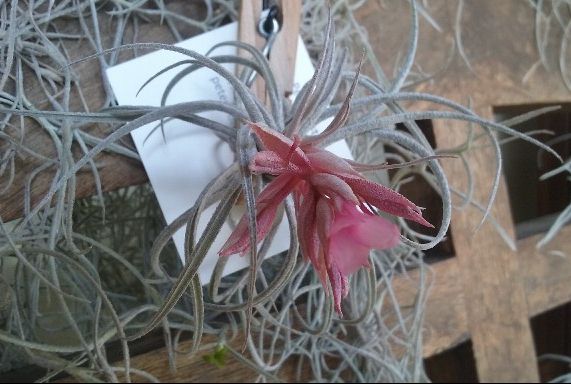
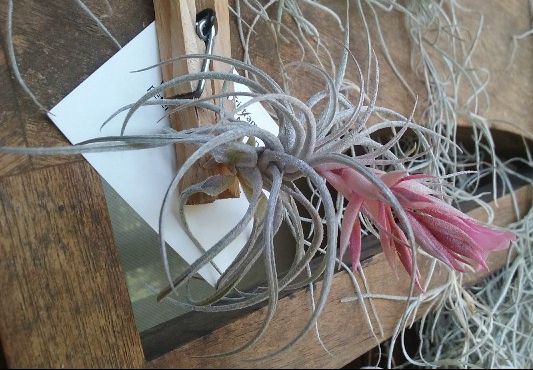

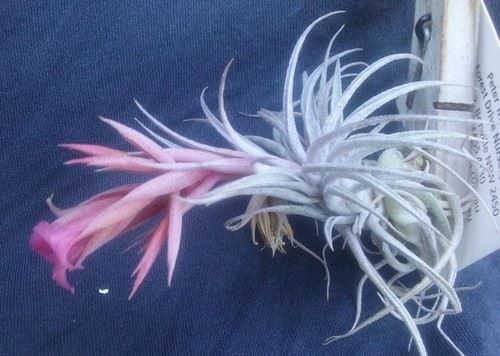

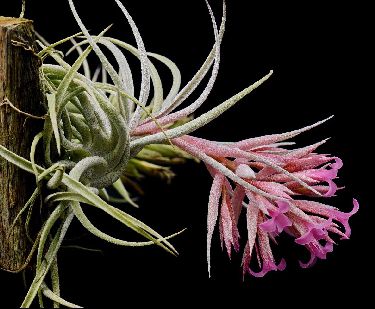
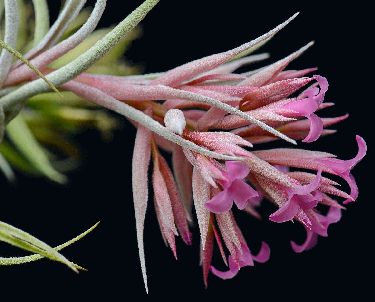
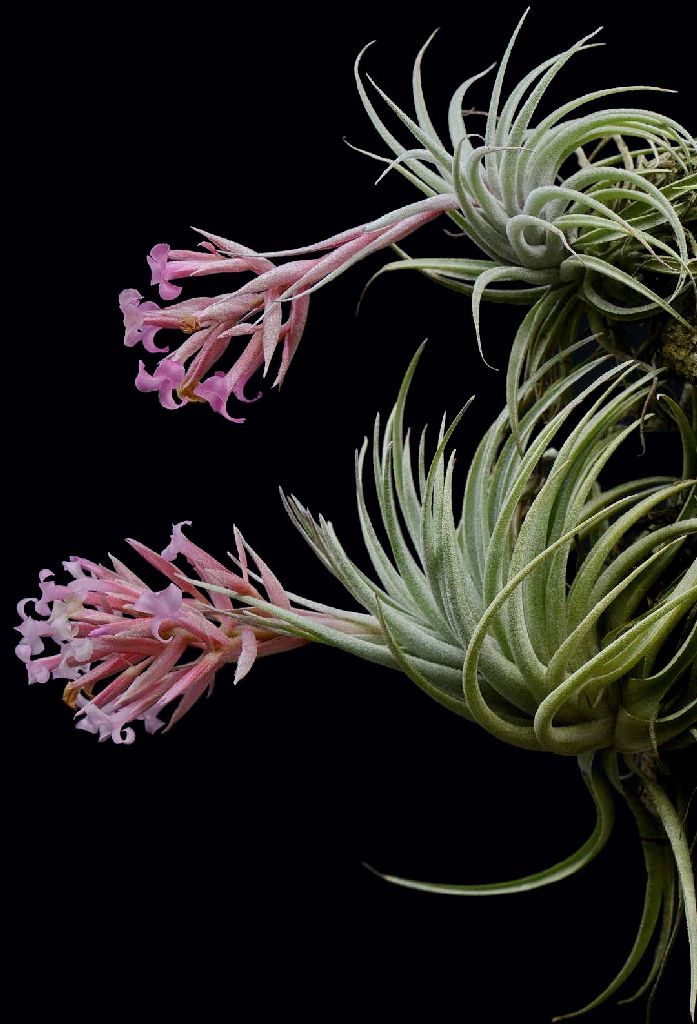
Peter Tristram 10/14...."Many of you will have bloomed the little red Brazilians over the winter months and the last to bloom for me is always the delightful T. sucrei. For such a small plant it has a monster inflorescence! This year is a real treat as all of my forms are in bloom, so lots of pollinating to get true sucrei seed too (and a few hybrids). The smaller form in the photo with the 2 plants is the one sucrei collectors all have, which was imported at least 30 years ago. The larger one I obtained from Goettingen Botanical Garden in Germany and is blooming for the first time. It is even larger than the other large form I have, also from a German BG, that I posted last year, and also in bloom. The flowers on the Goettingen plant are much paler than all of the other forms too and I have heard there is an alba form as well, though I’d have to go to Germany to have any hope of being at the right place at the right time to get a piece.
T. sucrei seems easy to grow on the east coast so I wonder how southern and western growers go with it? It’s natural habitat is smack bang in the middle of Rio, so very different to where something like T. yuncharaensis originates.


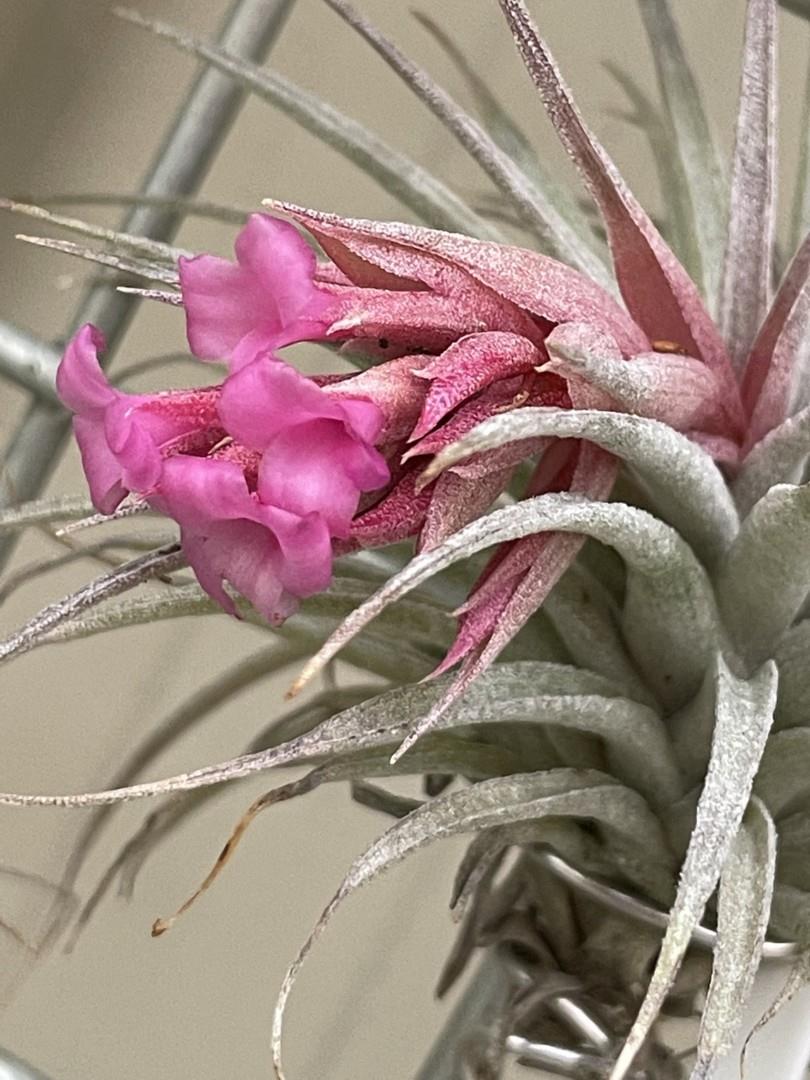
Key to Brazilian Tillandsias, with red or pink petals from Die Bromelie, Sonderheft 3 1996
1. Stamens - exceeding the flower tube => paraensis
- included in the flower tube => 2
2. Leaf blade - filiform and grasslike => globosa
- triangular => 3
3. Plant - 4 - 8 cm in diameter => 8
- 10 - 25 cm in diameter, forming a more or less spreading rosette, stemless => 4
4. Floral bracts - lepidote => 5
- glabrous or nearly so: Plant 6 - 15 cm diameter, inflorescence elliptic or globose, spikes elliptic, sublax with 1 - 3 (- 5) flowers, floral bracts carinate, glabrous or punctulate lepidote, sepals glabrous => roseiflora
5. Inflorescence - elliptic or subglobose => 6
- elongate => 7
6. Leaves - soft, green or reddish, appressed lepidote, spike lax, 2 - 4 flowered, floral bracts shorter than sepals, petals red - violet => geminiflora
- soft, grey, densely lepidote with spreading trichomes, spikes dense, 3 - 12 flowered, floral bracts densely lepidote, exceeding the lepidote sepals => gardneri
7. Leaves - subsucculent, stiff, inflorescence with 4 - 6 spikes => chapeuensis
- Plant only 11 - 13 cm in diameter, an open silvery star-shaped rosette, leaves appressed lepidote, inflorescence with 5 - 7 spikes => grazielae
8. Plant - short - caulescent => 9
- stemless, forming an erect, often subbulbose rosette, leaves often somewhat secund, inflorescence elliptic or subglobose, flowers red or violet, filament not plicate => 10
9. Plant - 3 to 5 cm in diameter, pine cone shaped, dorsiventral, pendant, leaves green, silvery appressed lepidote, inflorescence simple, distichous => reclinata
- 4 to 8 cm in diameter, an erect-secund rosette, the basal leaves recurved, leaves cinereous-lepidote, inflorescence compound, spikes lax, floral bracts carinate, shorter than the lepidote sepals, the posterior ones carinate and 4 mm connate => sucrei
10. Floral bracts - glabrous or nearly so => 14
- lepidote => 11
11. Inflorescence - simple => 12
- bipinnate: Leaves channelled, regularly lepidote with coarse cinereous scales, inflorescence with up to 8 spikes which are laxly 3 - 4 flowered, the posterior sepals carinate, 1/3 to 1/2 connate, lithophytic growing at sea level => brachyphylla
12. Inflorescence - with polystichous flowers => 13
- with distichous flowers: Plant ca. 4 cm in diameter, short caulescent, small pine cone shaped, pendant, leaves grey appressed lepidote => reclinata
13. Leaves - secund, thin and soft, grey with appressed trichomes, looking like grey velvet, scape densely lepidote, inflorescence simple, sometimes compound of up to 3-flowered spikes, floral bracts carmine-red, sepals slightly lepidote, free, posterior ones carinate, petals violet-rose => heubergeri
- Leaves not secund, subsucculent, green, covered with coarse grey scales, plant pendant, floral bracts rose, sepals more lepidote, petals pink => thiekenii
14. Posterior sepals - not carinate => 15
- carinate => 16
15. Leaves many, green-grey, densely lepidote with irregular cumulated coarse trichomes, appearing rough pruinose, epiphytic at sea level => sprengeliana
- Leaves many, narrow triangular, with appressed trichomes, appearing metallic, epiphytic 700 - 1000 m => kautskyi
16. Plant - 2.5 to 5 cm in diameter, rosette of broadly triangular leaves with shorter blade, very densely and regularly silvery subpruinose lepidote, appearing like silvery velvet, sepals carinate and short connate, lithophytic 1800 - 2200 m => organensis
- Plant bigger, up to 15 cm in diameter, rosette often bulbose, leaves grey - green appressed grey lepidote, appearing like grey velvet, bipinnate with 1 - 3 (-5 ) flowered spikes, floral bracts conspicuously carinate, posterior sepals carinate, epiphytic => roseiflora
Named after the Brazilian Botanist D. Sucre.
Comments: This small Tillandsia was for a long time a precious rarity, which grows endemic on steep rockfaces in the State of Rio de Janeiro and for that reason needs protection. The rockface however is almost vertical and therefore inaccessible. Therefore the species has a big chance to survive. There is a great variety in size to be observed, in one location is growing a type double in size as the normal one, named var. major.
Culture presents no real difficulty if one considers that the temperature rarely drops below 15° C.
Tillandsia sucrei E. Pereira, Rodriguesia 26(38): 115, pl. 4. 1971.
Plant saxicolous, caulescent, not dorsiventral, flowering to 10 cm high.
Leaves many, subfasciculate at the end of the stem, strongly secund, without distinction between sheath and blade, narrowly triangular, subulate-attenuate, 4-5 cm long, 7mm wide, nearly equaling the inflorescence, deeply channeled, rigid, covered with whitish, spreading scales.
Scape erect, red;
scape-bracts 3-4, imbricate, the sheaths ovate-oblong, red, the blades strongly secund, subulate, channeled, green.
Inflorescence bipinnate, except for the petals covered with whitish scales;
primary bracts ovate, acute or short-acuminate, concave, ecarinate, red, equaling the floral bracts or slightly shorter;
spikes 15mm long, 3-flowered including the sterile, terminal one.
Floral bracts ovate, acute, obtusely carinate, slightly shorter than the sepals;
flowers sessile, 20mm long.
Sepals lanceolate, acute, 13mm long, red the posterior carinate, connate for 4mm;
petals unguiculate with an asymmetric, suborbicular, apiculate blade, red-lilac, 18mm long, ca twice the stamens;
stamens with linear, complanate, plicate in the middle filaments, the anthers linear, obtuse at both ends, 8-10 times longer than the ovary;
ovary subglobose, trigonous;
style cylindrical elongate;
stigmas linear, fimbriate-papillose.
TYPE. P. I. Braga & D. Sucre 1715 (holotype RB, isotype HB), on steep rock faces, Morro do Pavao, Copacabana, Rio de Janeiro, Guanabara, Brazil, 19 Oct 1967.
DISTRIBUTION. Known from the type collection only.
It has similarities with T. brachyphylla and T. geminiflora but differs in the shape of the leaves, bracts and sepals.
It is dedicated to my colleague Dimitri Benjamin Sucre, Rubiaceae specialist at the Botanic Garden.